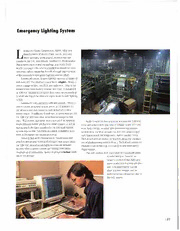
NASA Technical Reports Server (NTRS) 20020080084: Emergency Lighting System PDF
Preview NASA Technical Reports Server (NTRS) 20020080084: Emergency Lighting System
Emergency Lighting System L andmark Plastic Corporation, Akron, Ohio is a manufacturer of plastic trays, packs, pots and other specialty horticultural products for cus- tomers in the U.S. and abroad. Landmark's Maintenance Department reports that technology in a NASA Tech Briefs (see page 129) article provided an important cost- reducing, safety-enhancing benefit through improvement of the company's emergency lighting system (ELS). Landmark's main factory lighting consists of banks of 400 watt 277 VAC mercury vapor bulbs (right). When a power outage occurs, two ELS sets take over. One is the standard low watt battery system; the other is composed of 120 VAC incandescent lamps that come on automatical- ly when one leg of the mercury vapor main factory lighting is lost. Landmark had a problem with this system. When a the 120 VAC 200 watt ELS incandescent lamps to acti- vate. That meant that there was a period of as much as Keller's solution was a system where~nth e 120 VAC seven minutes before production could resume, a per~od bulbs are activated by any loss of voltage in the 277 VAC during which the l~ghstu pplied by the low watt battery main lamp circuit, coupled with photosensing devices system was so dim that lights mounted on forklifts were used to keep the ELS on until the 277 VAC primary mer- used to illum~natet he production area. cury lamps reach full brightness. Keller credits NASA Steve Keller of the Maintenance Department was Tech Briefs with an assist; he learned about the capabili- asked to design and build an ELS panel that would allow ties of photosensing devices from a Tech Briefs article on the 120 VAC incandescent lights to come on instanta- photodetector technology developed at Marshall Space neously after a power outage, permitting immediate Flight Center. resumption of production. Keller is pictured below work- The new system is in place and the Landmark plant lng on his design. is safer because there is no 1 longer a period of dim light and more productive because produc- tion is resumed more quickly after a power outage, and in manufacturing operations time is literally money.
